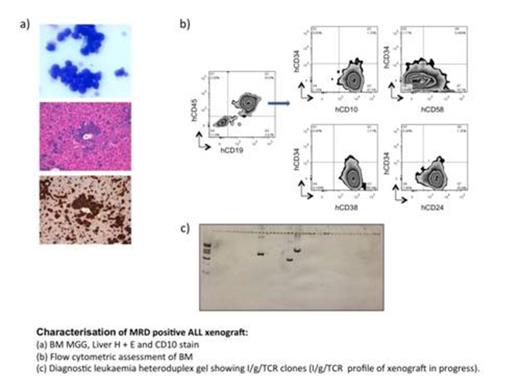Abstract
Although humanised models of ALL are well described they are largely based on paediatric disease. The distinct nature of ALL in adults - evidenced by inferior outcome and different genetic landscape - points to a need for targeted study of this disease. Key to this is development of in vivo models of adult ALL. In this study we sought to establish the optimal modelling system for adult pre-B ALL using NOD/LtSz-scid IL2Rγ nullc (NSG) mouse xenotransplantation approaches. Our aims were to define the conditions for sensitive assaying of adult ALL LIC and low frequency clones.
Pre-conditioning irradiation has been shown to negatively influence pre-B ALL engraftment. Studies of paediatric ALL suggest this may be due to reduced homing of ALL cells to the bone marrow (BM) resulting from aberrant CXCR4 receptor desensitisation induced by SDF-1 which is upregulated after irradiation. To investigate the impact of irradiation on engraftment of adult ALL, 5 - 10 million viable cells were injected intravenously (IV) into 6-8 week mice either unconditioned or (+24 hrs) following irradiation (2.5Gy). After 6 months, BM leukaemic engraftment (>0.1% hCD45+/19+) was assessed. Engraftment occurred in only 2/17 (11.8%) samples from non-irradiated recipients but in 11/14 samples (78.6%) after pre-conditioning irradiation (p = 0.0003). Comparison of 8 samples assayed by both models demonstrated that pre-conditioning irradiation was a pre-requisite for successful engraftment in 7/8 cases. Contrasting this overall finding was t(4;11) ALL where engraftment was higher in non-irradiated models (2/3).
To determine homing capacity in adult ALL, SDF-1 (0, 10ng, 50ng, 125ng + 1ug) induced directional migration was investigated. A dose dependant response was observed with maximal migration (37±15 fold) of adult pre-B ALL cells at high (125ng/ul) concentrations of SDF-1 (n=5, non t(4;11) ALL). Hence, in contrast to paediatric ALL, adult ALL tumours do not appear to exhibit significant CXCR4 desensitisation to high levels of SDF-1 which may explain the positive effect of irradiation on adult ALL engraftment. Notably, t(4;11) positive tumours were relatively insensitive to SDF-1 induced migration (max fold change ∼2.5). CXCR4 cell surface receptor analysis revealed a trend towards low expression in t(4;11) cases (8.7±3.3% blasts) vs non t(4;11) (41 ±12% blasts) which may account for the differential SDF-1 induced in vitro migration patterns.
Further modifications to the NSG xenotransplantation system were investigated: direct intra bone marrow (IBM) vs IV injection, 2.5Gy vs 2.0Gy and IBM +/- 2.5Gy irradiation. An IBM injection route, 2.5Gy irradiation and IBM + irradiation were all associated with an overall faster engraftment kinetic and time to disease manifestation. However, overall engraftment potential was not affected by these factors. Hence, the optimal xenotransplantation assay for adult ALL was defined as IBM delivery in 2.5Gy irradiated mice. This system enabled quantification of at least 1:1000 adult ALL LICs as assessed by limiting dilution transplantation (cell dose:103-106 ).
Finally, we used the optimised xenotransplantation system to study 9 MRD positive ALL BM samples (8.33 x 10-2 – 2.64-4 positivity by BCR/ABL or I/g TCR based PCR quantification). MRD positive BM samples (unfractionated) were injected at a cell dose of 8.7 x104 – 6 x106/mouse and, strikingly, in the absence of cellular enrichment, MRD induced leukaemic engraftment (83.6%) was achieved in 1/9 samples after an extended modelling phase of 7 months and importantly gave rise to overt leukemia associated morbidity. Hence we establish proof of principle, that MRD + ALL can be modelled in vivo.
No relevant conflicts of interest to declare.
Author notes
Asterisk with author names denotes non-ASH members.


This feature is available to Subscribers Only
Sign In or Create an Account Close Modal